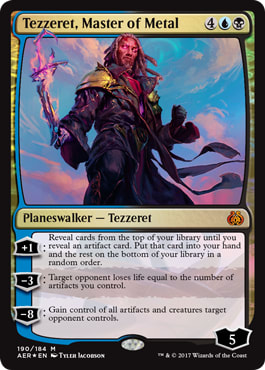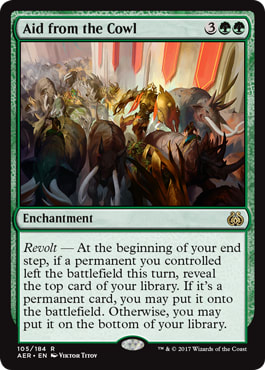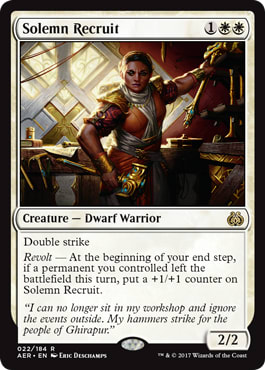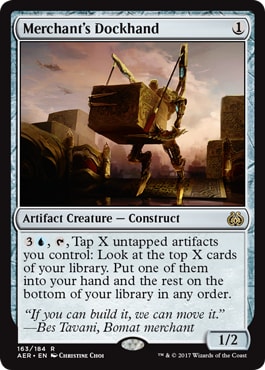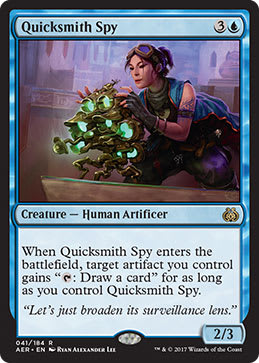It’s been an eventful few months here for Preconstructed Magic since the release of Kaladesh. We looked at the first-ever precon, the Quick Start Rivals release. We explored the history of Izzet- and Orzhov-colored Theme Decks and Intro Packs. We even tackled the Preconstructed offerings of Portal Second Age and Portal Three Kingdoms.
I always enjoy delving into the rich history of the game, to see where it’s come from and how it’s grown in depth and texture over the years. However, fun as all that is, nothing quite compares to the energy and excitement that surrounds the release of a new set. And while we may have fewer Preconstructed decks attacked to each set these days with the advent of the Planeswalker Decks, their debut in Kaladesh showed us that while the quantity is down, the quality went up.
One of the worries I held when approaching the end of the Intro Pack era was whether or not two decks would offer sufficient design space to serve as “museum pieces” for the sets they hail from. Whatever one thought of Theme Decks and Intro Packs (for quality indeed was subject to fluctuation), it was good to have products that featured and highlighted the different mechanical and thematic elements of a set. Not just for those playing at the time, mind, but also for those wanting to step into a time machine of sorts, and see what a set was like from Magic’s past.
Kaladesh used its two Planeswalker Decks not just to highlight Chandra and Nissa, but also to explore Vehicles and Energy. Although poor fabricate was left on the outside looking in, the occasional exclusion has happened before. Imprint was left out of the Scars of Mirrodin Intro Packs, for instance. With Aether Revolt introducing the new mechanics revolt and improvise, would we see the same level of representation for the sophomore Planeswalker Decks?
Let’s find out! We’ll begin with Ajani’s offering.
Planeswalker Deck: Ajani ? Planeswalker Deck| Wizards of the Coast
- Creatures (21)
- 1 Airdrop Aeronauts
- 1 Deadeye Harpooner
- 1 Ghirapur Guide
- 1 Ridgescale Tusker
- 1 Solemn Recruit
- 2 Armorcraft Judge
- 2 Lifecraft Cavalry
- 2 Narnam Renegade
- 2 Silkweaver Elite
- 2 Verdant Automaton
- 3 Ajani's Comrade
- 3 Audacious Infiltrator
- Planeswalkers (1)
- 1 Ajani, Valiant Protector
- Instants (1)
- 1 Natural Obsolescence
- Sorceries (6)
- 1 Engineered Might
- 1 Prey Upon
- 4 Inspiring Roar
- Enchantments (5)
- 1 Aid from the Cowl
- 2 Ajani's Aid
- 2 Unbridled Growth
- Artifacts (4)
- 1 Daredevil Dragster
- 3 Renegade Map
- Lands (22)
- 9 Forest
- 9 Plains
- 4 Tranquil Expanse
Ajani’s deck is clearly a revolt deck, with plenty of rewards for you if you manage to have a permanent leave the battlefield. A number of these are one-shots, which check for the revolt condition when entering the battlefield. Narnam Renegade, for instance, picks up a +1/+1 counter, while the Lifecraft Cavalry can get two of them. The Airdrop Aeronauts dangle some lifegain in front of you, while the Silkweaver Elite can replace itself in your hand. The Deadeye Harpooner even offers some removal, offering a free Vengeance if you manage to activate revolt.
Other uses of the mechanic act almost like enchantments, checking the battlefield repeatedly over the course of successive turns. Aid from the Cowl and Solemn Recruit can trigger multiple times a game, depending on how often you’re seeing something leave the battlefield. And there’s the trick of the deck — just how often will that be?
The deck has a heavy reliance on +1/+1 counters, beyond even the scope of revolt. Indeed, it’s easy to suspect that the theme of Ajani’s deck is “+1/+1 counters matter,” especially given that the deck’s marquee card, Ajani himself, can throw a couple onto the battlefield every turn. Heck, you even get a full playset of Inspiring Roar, which gives a +1/+1 counter to every creature you control. Funnily enough, though, you only find one card in all the 60 that directly interacts with how successful you’ve been at growing your creatures through counters: Armorcraft Judge.
Don’t get me wrong, that’s not a bad payoff for the work. The Judge can easily put you up on cards given how many ways there are to maximize the +1/+1 counters, but ultimately it seems that creature growth in the deck is done for its own sake, and not part of some grander scheme or design. If you’re looking for clever play, it’s going to be with revolt.
Just like with the +1/+1 counters, there’s a natural expectation in Magic to find a way to break a mechanic open in your favor. In a deck where permanents leaving the battlefield matters, you might anticipate cards that can abuse the mechanic to wring out the power hidden within. A card like Kor Skyfisher comes to mind, which gives you an above-average creature in exchange for having to deal with a drawback- a drawback that itself can fuel revolt.
Aether Revolt does have cards like this, on-color for this deck. The Aegis Automaton isn’t a great card, but it can help you trigger revolt as needed, provided you have enough mana to take advantage of it. Need a cheaper option? Look no further than Conviction, a reprint from Stronghold almost certainly brought back to serve as a revolt enabler. You might even make a case for the Restoration Specialist, which could bring back a Conviction and Daredevil Dragster, for instance.
Instead, Ajani’s deck remains a very “what you see is what you get” construction. If you’re going to want to take advantage of revolt, you’re going to have to put in the hard work of making things leave the battlefield the old-fashioned way: through combat. That’s the upside of having so many creatures that benefit from seeing their peers fall in the red zone before being summoned. Your opponent is not only going to have to consider the flow of play in combat, but also whether or not there’s a risk associated with killing one of your creatures. Since most of your revolt triggers are found on creatures, it’s worth noting that this will mainly apply to you being the attacker.
But hey, at least you’ll have some +1/+1 counters to work with.
Planeswalker Deck: Tezzeret ? Planeswalker Deck | Wizards of the Coast
- Creatures (20)
- 1 Barricade Breaker
- 1 Dukhara Peafowl
- 1 Fen Hauler
- 1 Foundry Assembler
- 1 Ironclad Revolutionary
- 1 Merchant's Dockhand
- 1 Ornithopter
- 1 Quicksmith Spy
- 1 Treasure Keeper
- 2 Augmenting Automaton
- 2 Bastion Inventor
- 2 Dhund Operative
- 2 Wind-Kin Raiders
- 3 Tezzeret's Simulacrum
- Planeswalkers (1)
- 1 Tezzeret, Master of Metal
- Instants (1)
- 1 Essence Extraction
- Sorceries (3)
- 1 Reverse Engineer
- 2 Tezzeret's Betrayal
- Enchantments (2)
- 2 Tezzeret's Touch
- Artifacts (8)
- 2 Implement of Examination
- 2 Universal Solvent
- 4 Pendulum of Patterns
- Lands (25)
- 10 Swamp
- 11 Island
- 4 Submerged Boneyard
Moving on to Tezzeret, we see here that his deck is home to improvise, Magic’s newest cost-reduction mechanic. While some noted that these sorts of mechanics have proven dangerous for Magic design in the past, one can rest assured that there’s little risk of anything breaking wide open in this deck. Rather, improvise is (naturally) married to a heavy-artifact theme for the second Planeswalker Deck as a way to tease out a little more synergy.
With Ajani’s deck, there wasn’t a lot of synergy between the two prominent themes of +1/+1 counters and revolt, they just sort of overlapped one another. With Tezzeret, both halves of the deck line up perfectly.
The first half is the artifact half. Not surprisingly, Tezz is surrounded with them. Over half of the deck’s score of creatures are artifact creatures, and the deck adds in another eight of the conventional type. These cards don’t exist in a vacuum, but rather help some of the deck’s other inclusions to reach their fullest potential.
Sometimes it’s a simple binary operation, as in the case with the Dhund Operative. Control an artifact and it’s a 3/2 with deathtouch. If you don’t, it’s a simple two-mana 2/2 (though it should be pointed out that historically speaking, there’s nothing “simple” about a common two-mana 2/2 with an upside in Black, which had to endure Scathe Zombies as the standard-bearer for years). Offer up an artifact to the Ironclad Revolutionary, and it comes in with a much more robust threat.
Other times, it’s a longer-term prospect. The Merchant's Dockhand has a repeatable ability whose strength is entirely reliant upon the number of artifacts you have in play. Tezzeret's Touch is an Aura that turns any artifact in to a 5/5 artifact creature, a nod to the original ultimate ability of Tezzeret the Seeker. The new Tezzeret can inflict life loss equal to the number of artifacts you’ve managed to field, and with the Quicksmith Spy, you can turn any artifact into a card-drawing machine for as long as the Spy is in play.
Then there’s the deck’s second component, the improvise cards. Most of these are on your most substantial creatures, helping you power out a closer that much sooner with the help of your artifact collection. The Bastion Inventor is a 4/4 with hexproof, while the Wind-Kin Raiders is a 4/3 with flying. None of these are particularly dangerous in an environment without a ton of 0-cost artifact cards (you get one, the classic Ornithopter).
There is one non-creature card to carry the keyword, and that’s Reverse Engineer. Improvise isn’t really pushed here; rather, it’s just a way to reward you for doing what the deck wants you to do, which is build up on artifacts and harness their synergies. Tezzeret, Master of Metal is very similar in design to Ajani, Valiant Protector in that both let you find permanents from your library (artifacts and creatures, respectively). Tezzeret gets the nod for being a little more tied in to the deck, thematically.
Overall, it looks encouraging that the designers of the Planeswalker Decks are pushing the set’s themes and mechanics even more than the Planeswalkers themselves. As with the Kaladesh decks, there are some new cards here that interact with the new Planeswalkers, but they remain something of a subtheme. The deck isn’t going to live or die based on whether you can find a Tezzeret's Simulacrum while Tezz is on the field, but rather on how well you can keep your artifact orchestra playing together.
That was the other worry I had with the Planeswalker Decks, that they’d be more about the Planeswalkers and less about the sets. With two sets of Planeswalker Decks now in circulation, that concern appears to have been groundless. These decks are very much creatures of Kaladesh/Aether Revolt, and that’s a characteristic I hope continues.
The museum demands it!

















